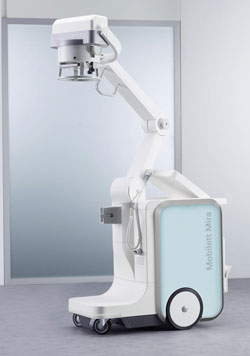More flexibility in X-ray imaging: Siemens presents its latest mobile X-ray system with a wireless detector at the ECR 2011

The detector sends image data via W-LAN to an integrated imaging unit and particularly facilitates examinations of patients that are critically ill and have only limited mobility. Moreover, a new, rotating swivel arm increases ease of use for the clinical staff.
Mobilett Mira will be introduced for the first time at the European Congress of Radiology (ECR) 2011 in Vienna. Mobile X-ray systems are frequently used in hospitals, particularly where patients cannot be moved into an X-ray room – as, for example, in the intensive care unit. Until now, these system’s X-ray detectors that are placed directly under the patient and convert radiation into digital image information, are usually connected to the system via a data cable. This cable can impede the examiner, especially when positioning patients with limited mobility. Now, with the new mobile digital X-ray system Mobilett Mira, Siemens connects the advantages of mobile x-ray imaging with the flexibility of a wireless detector.
Mobilett Mira is one of the smallest mobile X-ray systems on the market and can be easily moved thanks to an integrated drive. The new detector provides a resolution of more than seven million pixels, delivering excellent image quality comparable to high-resolution stationary systems. The system works with very short exposure times beyond one millisecond, thus reducing the radiation exposition for the patient. Furthermore, Siemens redeveloped its mobile X-ray imaging swivel arm system for the new Mobilett Mira. In addition to vertical movements, the new swivel arm can now also be moved horizontally up to 90 degrees. This makes the preparation of the examination even easier. Moreover, the swivel arm integrates all electric connection cables that conventional mobile X-ray systems usually carry at the outside. In combination with the wireless detector, this makes Mobilett Mira a fully wireless mobile system. Thus the system’s utilization becomes not only more flexible and safer, but also more hygienic: Every cable on a medical device is a potential germ carrier and demands more time for regular maintenance and cleaning.
With Mobilett Mira, Siemens offers the first system on the market for mobile X-ray imaging that can be maintained and updated using remote monitoring. Via data cable or W-LAN, Siemens Remote Services (SRS) provides the system regularly with recommended software updates. Whenever required, a Siemens service engineer logs onto the system, can analyze failures and, for example, determine which spare parts are required on-site.
The Siemens Healthcare Sector is one of the world’s largest healthcare solution providers and a leading manufacturer and service provider in the fields of medical imaging, laboratory diagnostics, hospital information technology and hearing instruments. It offers solutions covering the entire supply chain under one roof – from prevention and early detection to diagnosis and on to treatment and aftercare. By optimizing clinical workflows oriented toward the most important clinical pictures, Siemens also strives to make healthcare faster, better and, at the same time, less expensive. Siemens Healthcare currently has some 48,000 employees worldwide and is present throughout the world. During fiscal 2010 (up to September 30) the Sector posted sales worth 12.4 billion euros and profits of around 750 million euros.
The product mentioned herein is not commercially available. Due to regulatory reasons its future availability cannot be guaranteed.
Media Contact
More Information:
http://www.siemens.com/healthcareAll latest news from the category: Trade Fair News
Newest articles

Superradiant atoms could push the boundaries of how precisely time can be measured
Superradiant atoms can help us measure time more precisely than ever. In a new study, researchers from the University of Copenhagen present a new method for measuring the time interval,…

Ion thermoelectric conversion devices for near room temperature
The electrode sheet of the thermoelectric device consists of ionic hydrogel, which is sandwiched between the electrodes to form, and the Prussian blue on the electrode undergoes a redox reaction…

Zap Energy achieves 37-million-degree temperatures in a compact device
New publication reports record electron temperatures for a small-scale, sheared-flow-stabilized Z-pinch fusion device. In the nine decades since humans first produced fusion reactions, only a few fusion technologies have demonstrated…





















